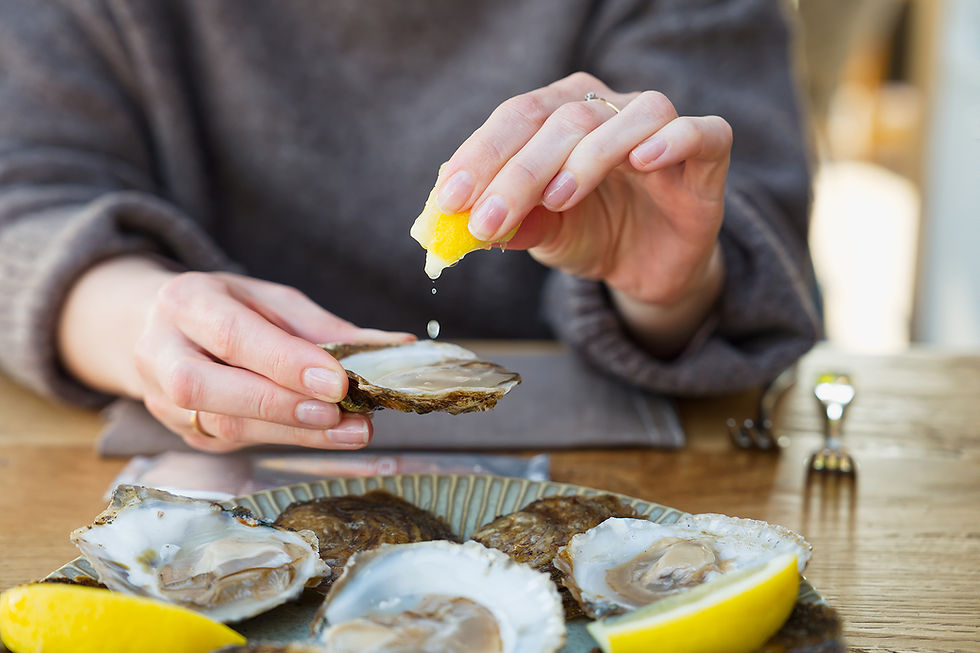From Spawn to Shell: The Life Cycle of an Oyster
- Laura Kuhn

- Jul 24
- 3 min read

🌊 How a Tiny Larva
Becomes a Culinary Treasure
At Shelley Farms, our oysters are more than just a delicacy—they’re the result of a remarkable journey that begins as microscopic larvae and ends on your plate, perfectly briny and bursting with Gulf flavor. Understanding the oyster life cycle not only helps us farm responsibly, but also connects you, the consumer, to the rich, natural process that makes our oysters so special.
Let’s take a look at how an oyster grows, thrives, and becomes one of Louisiana’s most iconic seafood staples.
🐣 Stage 1: Spawning and Fertilization
Oysters are dioecious, meaning they have separate sexes—but they can also change gender depending on environmental factors and population needs. Spawning typically begins when water temperatures rise in the spring and summer. Male oysters release sperm and females release eggs directly into the water.
Fertilization occurs externally, and within hours, the fertilized egg begins to divide rapidly and enters the trochophore stage, followed by the veliger larva stage—tiny, free-swimming organisms that drift with the currents.
🌀 Stage 2: Larval Development
During this free-swimming phase, the veliger larvae begin to develop a shell and tiny hairs (cilia) used for movement and feeding. As they mature, they transition into pediveliger larvae, which are equipped with a small “foot” and two eye spots that help them find a suitable surface for settlement.
This is a critical stage where the oyster prepares to leave the water column and settle onto a hard surface—a process known as “setting.”
🪨 Stage 3: Setting and Spat Formation
Once a pediveliger finds the right spot—usually a clean, hard shell or substrate on the ocean floor—it cements itself in place and becomes what’s called a spat. This is the beginning of its life as a stationary shellfish.
At Shelley Farms, we use off-bottom aquaculture methods, where oyster larvae (spat) are carefully placed into mesh baskets suspended in the water. This not only protects them from predators and sediment but also encourages clean, beautiful shell formation.
⏳ Stage 4: Growth and Maturity
Over the next 1 to 3 years, the oyster grows, feeding on plankton and filtering large volumes of water each day. As it matures, its shell thickens and its flavor profile deepens—shaped by the salinity, temperature, and nutrients of the Gulf waters we farm in.
At full size, an oyster can filter 30 to 50 gallons of water a day, making it not only a sustainable food source but a critical component of coastal health.
🛶 Stage 5: Harvest and Beyond
Once they reach market size, oysters are either:
Hand-harvested from our farm baskets for boutique raw bars
Dredged from public reefs for wild-caught half shells
Or processed and packed for grilling, shucking, and other culinary uses
Our team inspects, tags, and refrigerates every oyster to maintain quality and safety—all before it ever hits your plate.
🦪 The Full Circle: Nature + Stewardship
The life cycle of an oyster is a beautiful example of resilience and environmental synergy. From drifting larvae to filter-feeding adults, every stage is a critical part of our coastal ecosystem—and a testament to the care we take at Shelley Farms to grow oysters that are as sustainable as they are delicious.
Next time you slurp a Shelley Farms oyster, remember: that briny bite carries a whole story of life, water, and tradition.





Comments